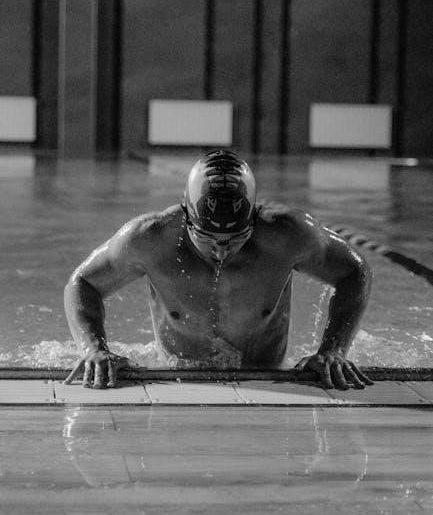A structured swimming program for beginners, designed to build confidence, endurance, and technique. It provides a progressive approach to improvement, focusing on safety, consistency, and measurable progress.
Overview of the Program
The swimming training program for beginners is a structured, progressive plan designed to improve efficiency and endurance. It combines basic drills, endurance exercises, and interval training to help swimmers build confidence and skill. The program typically lasts several weeks, with sessions held 2-3 times a week. It focuses on mastering fundamental techniques, increasing stamina, and promoting consistency. The plan is tailored for those new to swimming or looking to enhance their current abilities. It emphasizes safety, proper form, and gradual progression, ensuring a well-rounded approach to becoming a proficient swimmer.
Benefits of a Structured Training Plan
A structured swimming training plan offers numerous benefits for beginners, including improved efficiency, increased confidence, and measurable progress. It helps swimmers set clear goals and maintain consistency, ensuring steady improvement. A well-designed plan also reduces the risk of injury by focusing on proper technique and gradual progression. Additionally, it provides motivation and accountability, keeping swimmers engaged and committed to their development. By following a structured program, beginners can build endurance, master fundamental skills, and enjoy a more rewarding swimming experience, setting a strong foundation for future advancements in their swimming journey.
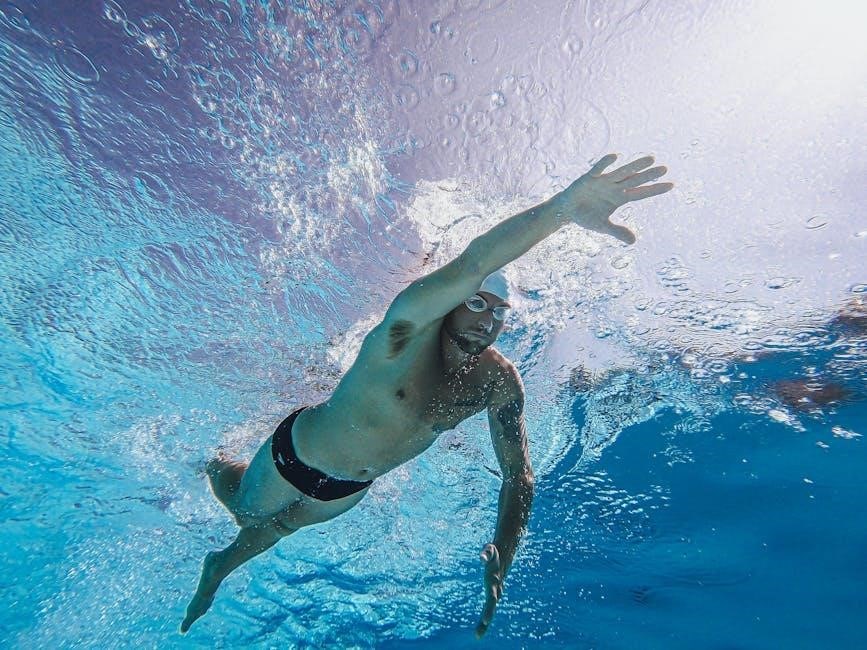
Setting Goals for Beginners
Setting clear, realistic goals helps beginners stay motivated and track progress. Aim to achieve specific milestones, like swimming a full length or mastering a stroke, to build confidence and technique gradually.
Realistic Expectations for Improvement
Beginners should expect gradual progress in swimming, with noticeable improvements in technique and endurance over weeks of consistent practice. Patience is key, as mastering strokes and building stamina takes time. Setting achievable milestones, like swimming a full length without stopping, helps track progress. Each session should focus on small advancements, celebrating incremental successes. With dedication, most beginners can achieve basic proficiency in a few months, laying a strong foundation for further development in the sport.
Tracking Progress Throughout the Program
Monitoring progress is essential for motivation and adjustment. Beginners should track stroke efficiency, endurance, and speed improvements. Using a swim log to record distances, times, and technique feedback helps identify strengths and areas for focus. Setting specific, measurable goals, like completing a certain distance without stopping, provides clear targets to aim for. Regularly reviewing progress ensures the program remains challenging yet achievable, keeping swimmers motivated and engaged throughout their journey. Celebrating small victories helps maintain consistency and builds confidence in their abilities.
Understanding Basic Swimming Techniques
Mastering body position, alignment, and breathing is crucial. Techniques include efficient arm movements and kicks, ensuring minimal resistance and maximum propulsion in the water for all strokes.
Body Position and Alignment
Maintaining a streamlined body position is essential for efficient swimming. Beginners should focus on aligning their ears, shoulders, and hips horizontally in the water. A straight spine and slight engagement of the core help reduce drag. Proper alignment allows for better stroke mechanics and energy conservation. Practicing floating and kicking exercises can help develop this awareness. Instructors often emphasize the importance of a balanced position to enhance speed and control, making it a fundamental skill in any training program for swimmers.
Kicking Techniques for Different Strokes
Kicking is a fundamental aspect of swimming, varying across strokes. For front crawl, a steady flutter kick keeps the body streamlined. Backstroke uses a similar alternating motion but on the back. Breaststroke requires a frog-like whip kick, bending knees and pushing legs outward. Practicing each kick with a kickboard helps build strength and coordination. Focus on maintaining rhythm and control, as improper technique can waste energy. Drills like underwater kicks and flip turns enhance efficiency. Mastering these kicks is crucial for improving stroke mechanics and overall swimming performance in any training program.
Arm Movements and Stroke Efficiency
Arm movements are crucial for stroke efficiency, with proper hand positioning and timing essential for reducing drag. For front crawl, keep elbows high and pull with the entire arm. Breaststroke requires a circular motion, while backstroke involves wide, alternating sweeps. Focus on engaging the shoulders and maintaining a consistent rhythm. Overreaching or crossing over can waste energy. Drills like catch-up and finger-tip drills improve coordination and power. Stroke efficiency is key to conserving energy and swimming longer distances effectively, making it a cornerstone of any training program for beginners aiming to enhance their swimming performance.
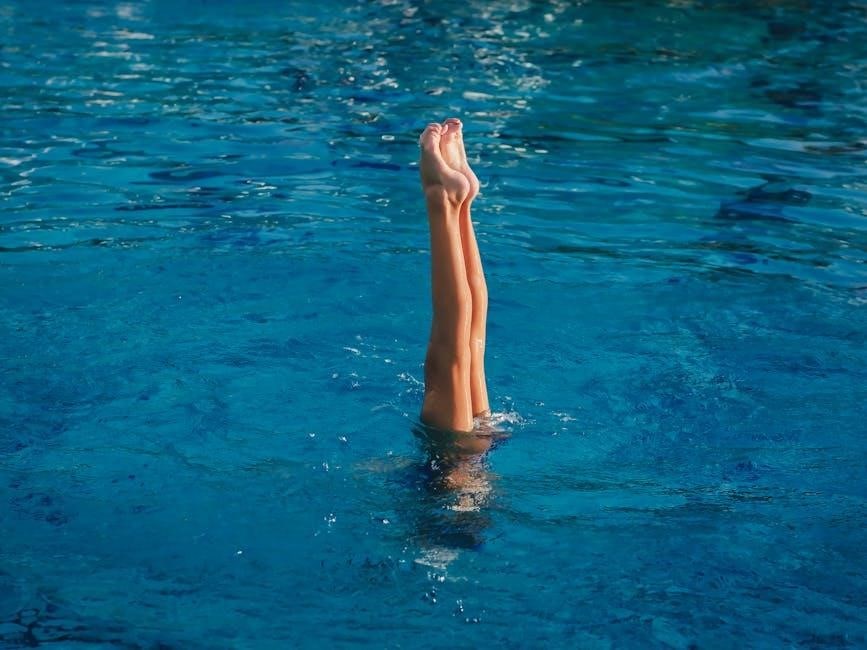
Warm-Up and Cool-Down Routines
A proper warm-up includes light swimming and stretching to prepare muscles and improve flexibility. A cool-down involves gentle exercises to gradually lower heart rate and prevent stiffness, enhancing recovery.
Importance of Warming Up Before Swimming
Importance of Warming Up Before Swimming
Warming up is essential to prepare the body for swimming, improving circulation and flexibility while reducing injury risk. It enhances stroke efficiency and mental focus, ensuring a safe start. Dynamic stretches and light cardio are key components, promoting muscle readiness and oxygen flow. A proper warm-up also prevents sudden muscle strain and cramps, allowing for a more effective workout. It sets the foundation for a productive session, helping swimmers perform at their best and adapt to the program’s demands without discomfort or fatigue.
Effective Cool-Down Exercises
Cooling down after swimming is crucial for gradual recovery, reducing muscle tension, and improving flexibility. Gentle swimming laps or light strokes help lower heart rate and remove waste products. Static stretches for shoulders, hamstrings, and hips enhance mobility. Breathing exercises promote relaxation and reduce stress. Incorporating pool-based stretches, such as leg swings or arm circles, further aids recovery. A proper cool-down prevents stiffness, supports injury prevention, and ensures the body transitions smoothly back to rest. Consistent cool-down routines enhance overall training adaptation and prepare the body for future sessions.
Safety Guidelines for Beginners
Always check pool rules, swim with a buddy, and follow emergency procedures. Ensure proper supervision and consult a healthcare provider before starting any exercise program.
Pool Etiquette and Safety Tips
Always shower before entering the pool and avoid swimming alone. Follow pool rules, such as no running or diving in shallow areas. Be mindful of lane etiquette, allowing faster swimmers to pass. Keep the pool area clean and respect fellow swimmers. Never swim during thunderstorms and learn basic water rescue techniques. Ensure a lifeguard is present and follow their instructions. Keep emergency equipment accessible and know how to use it. Familiarize yourself with pool depth and markings before starting your workout.
Supervision and Emergency Procedures
Always swim under the supervision of a qualified instructor or lifeguard, especially as a beginner. Ensure emergency equipment, such as a first aid kit and rescue buoy, is accessible. Learn basic first aid and CPR techniques. In case of a swimmer experiencing distress, alert the lifeguard immediately. Practice emergency exit procedures and know the location of pool exits. Establish clear communication methods, such as whistle signals, to quickly address issues; Regularly review safety protocols to prepare for unexpected situations. A safe environment fosters confidence and allows swimmers to focus on their training effectively.
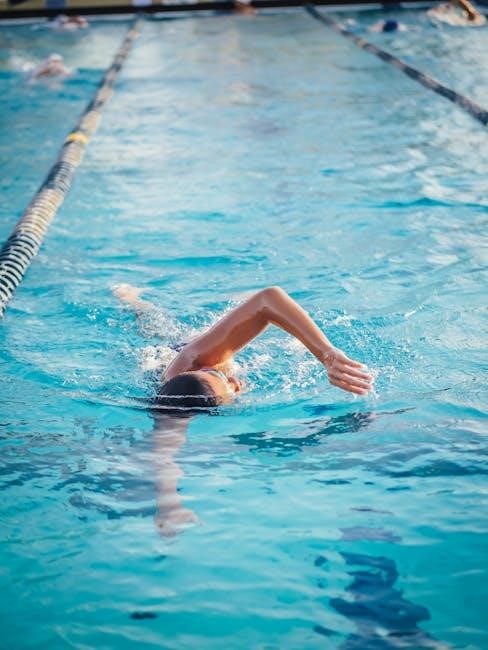
Core Workout Plan for Beginners
A beginner’s core swimming plan involves 2-3 sessions weekly, focusing on stroke drills, endurance exercises, and interval training. Aim to swim 600m by the program’s end.
Basic Drills for Stroke Improvement
Drills like the high-elbow catch and fingertip drag enhance stroke efficiency. Kicking exercises, such as flutter kicks and frog kicks, improve leg strength. Body position drills ensure alignment, reducing drag and boosting speed. Breathing techniques, like blowing bubbles, help swimmers stay relaxed. These drills are essential for building a strong foundation and improving overall technique, making strokes more effective and less tiring. Regular practice ensures consistent progress, helping beginners master each stroke confidently and efficiently.
Endurance Building Exercises
Endurance exercises focus on increasing stamina and cardiovascular fitness. Swimming multiple lengths at a steady pace improves heart rate and lung capacity; Interval training, alternating between fast and slow laps, boosts endurance and speed. Gradually increasing swim distances over time builds long-term stamina. Incorporating rest periods between sets ensures recovery and prevents fatigue. Consistency is key, as regular practice strengthens muscles and enhances overall endurance. These exercises help beginners progress from shorter to longer swims confidently and efficiently, preparing them for more advanced training.
Incorporating Interval Training
Interval training alternates between high-intensity bursts and recovery periods, enhancing cardiovascular fitness and speed. For beginners, it involves swimming short distances at maximum effort, followed by rest or slow laps. This method boosts endurance, increases stroke efficiency, and prevents plateaus. Examples include sprinting 50 meters followed by a 100-meter cool-down. Gradually increasing the number of intervals over time challenges the body and builds stamina. Consistency in interval workouts accelerates progress, making it a powerful tool for improving swimming performance and overall fitness in a structured, goal-oriented manner.
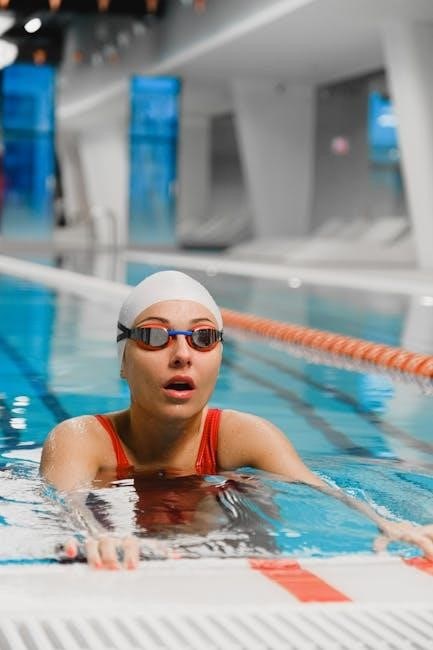
Nutrition and Recovery
A balanced diet rich in protein, complex carbs, and healthy fats supports muscle repair and energy. Hydrating properly and ensuring adequate rest aids recovery and performance optimization.
Optimal Diet for Swimmers
A swimmer’s diet should focus on balanced nutrition to fuel performance and aid recovery. Protein-rich foods like lean meats, fish, and legumes are essential for muscle repair. Complex carbohydrates from whole grains, fruits, and vegetables provide sustained energy. Healthy fats, such as those from nuts and avocados, support overall health. Hydration is crucial, so swimmers should drink plenty of water throughout the day; Additionally, avoiding heavy meals before workouts and timing nutrient intake around training sessions can enhance endurance and recovery.
Hydration and Recovery Strategies
Proper hydration is vital for swimmers, as water loss can impair performance. Aim to drink water before, during, and after sessions. Sports drinks can replenish electrolytes during intense workouts. Post-swim recovery includes stretching, foam rolling, and cold therapy to reduce muscle tension. Adequate sleep and rest are crucial for muscle repair and energy replenishment. A balanced diet supports recovery by providing necessary nutrients. Incorporating recovery techniques, like light cardio or yoga, can enhance flexibility and reduce soreness. Consistent hydration and recovery practices ensure optimal performance and prevent injuries;
Completing the program marks a significant achievement. Celebrate progress and set new goals. Continue refining techniques and building endurance to advance your swimming journey confidently.
Motivational Tips for Consistency
Staying motivated is key to progress. Set achievable milestones and celebrate small victories. Track improvements to visualize growth. Incorporate variety in workouts to avoid monotony. Surround yourself with supportive swimmers or a coach for encouragement. Reward consistency with non-food incentives; Focus on long-term goals and remind yourself why you started. Embrace challenges as opportunities to grow. Stay positive and remind yourself that progress takes time. Consistency breeds confidence and mastery in swimming.
Advanced Training Opportunities
After mastering the basics, swimmers can explore advanced techniques and challenges. Consider enrolling in specialized workshops or joining competitive events to test skills. Personalized coaching can refine stroke efficiency and speed. Incorporate dryland exercises for enhanced strength and flexibility. Mentorship programs offer guidance from experienced swimmers. Exploring open-water swimming or triathlon training can add variety. Advanced training fosters growth, helping swimmers achieve new levels of performance and confidence. These opportunities are designed to challenge and inspire, ensuring continued progress in the swimming journey.
